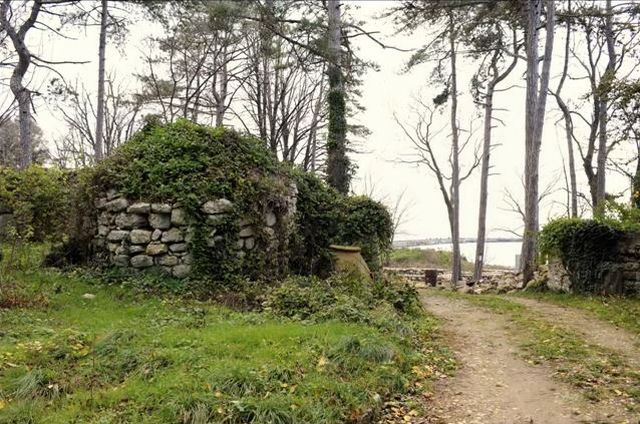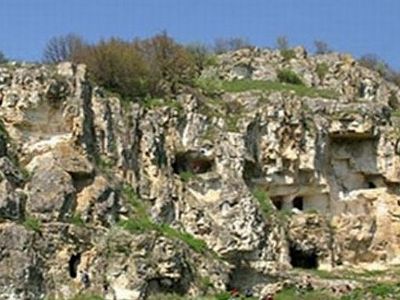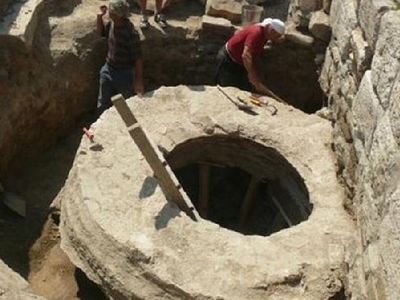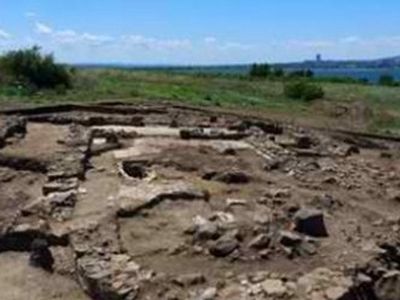July 30, 2015
 Coins of 14th century rulers of the Second Bulgarian Empire, the Dobrudzha Despotate, the Ottoman Empire, Wallachia, Moldova, Poland, the Tartar Khanates, and Egypt have been discovered in the lastest archaeoloical excavations in the Kastritsi Fortress near Bulgaria's Varna.
Coins of 14th century rulers of the Second Bulgarian Empire, the Dobrudzha Despotate, the Ottoman Empire, Wallachia, Moldova, Poland, the Tartar Khanates, and Egypt have been discovered in the lastest archaeoloical excavations in the Kastritsi Fortress near Bulgaria's Varna.
The archaeologists excavating the Late Antiquity and medieval Byzantine and Bulgarian fortress Kastritsi, which is located in the Euxinograd Residence of the Bulgarian government near the Black Sea city of Varna, have discovered medieval Christian artifacts as well as a treasure of Bulgarian and Ottoman coins.
\The newly found Christian artifacts from Kastritsi are a church procession cross and a medallion with the image of the Holy Mother of God, i.e. the Virgin Mary, Prof. Valentin Pletnyov, Director of the Varna Museum of Archaeology (Varna Regional Museum of History) has told Radio Focus Varna.
The church procession cross is made of bronze. It bears an inscription in Greek reading “St. John the Forerunner” – one of the nicknames of St. John the Baptist used in Eastern Orthodox Christianity.
The cross has been found during the excavations of a building in the Kastritsi Fortress. On its ground floor, the Bulgarian archaeologists have also discovered ceramic vessels with the so called sgraffitodecoration as well as the medallion with the image of the Virgin Mary which appears to be made ofsilver.
In addition to these medieval Christian artifacts, the archaeologists excavating Kastritsi havediscovered what has been described as a small treasure of coins from the so called Despotate of Dobrudzha, also known as the Principality of Karvuna – a Bulgarian feudal state located in today’s Northeast Bulgaria and Southeast Romania, i.e. in the region of Dobrudzha, which existed at the end of the 14th century AD, after the local feudal lord Despot Dobrotitsa (r. 1347-1386 AD) seceded from the already weakened Second Bulgarian Empire (1185-1396).
The archaeologists have found over 80 coins minted by Despot Dobrotitisa, which is taken as a testimony to the power of the Dobrudzha Despotate before it was conquered by the invading Ottoman Turks at the end of the 14th century.
The other set of really intriguing and rare coins discovered by the Bulgarian archaeologists during the2015 summer excavations of the Kastritsi Fortress is made up of coins of Ottoman Sultan Bayezid I the Lightning (r. 1389-1402 AD), who conquered most of the still surviving territory of the Second Bulgarian Empire, and his son Emir Suleiman.
The archaeologists have also found coins minted by the Bulgarian Tsar Ivan Alexander (r. 1331-1371 AD), as well as coins of the rulers of the principalities of Wallachia and Moldova, which at the time were allied with Bulgaria, as well as coins from Poland, the Tartar Khanates, and the sultans of Egypt.
All of these coins are taken to mean that the Dobrudzha Despotate and the Kastritsi Fortress in particular participated in lively trade with the states in the Black Sea and the Eastern Mediterranean region in the 14th century.
Coins of the Bulgarian Tsar Ivan Alexander which were minted in a previously unknown mint located somewhere between today’s Bulgarian cities of Dobrich and Varna have recently been found in the excavations of the ancient and medieval fortress of Missionis, also known as Krum’s Fortress, near thenortheastern city of Targovishte.
The Late Antiquity and medieval fortress of Kastritsi is said to be especially “lucky” among Bulgaria’s thousands of archaeological sites because its ruins have been located inside the enclosed and secure area of the Euxinograd Residence of the Bulgarian government since the last quarter of the 19thcentury, and have thus been inaccessible for the numerous treasure hunters and looters who have managed to destroy scores of other sites that may have been equally well preserved just a few decades ago.
Last week the Bulgarian archaeologists excavating the Early Byzantine and medieval Bulgarian cityand fortress of Kastritsi in the Euxinograd Residence of the Bulgarian government near Varnaunearthed an entire residential quarter from the Middle Ages.
The 30-day 2015 summer archaeological excavations of Kastritsi are funded with a total of BGN 15,000 (app. EUR 7,600) by the Bulgarian Ministry of Culture.
Background Infonotes:
The Late Antiquity Byzantine and medieval Bulgarian fortress and city of Kastritsi is located to the northeast of the Bulgarian Black Sea city of Varna, in the Euxinograd Residence of the Bulgarian government on the northern coast of the Bay of Varna. It occupies the St. George (St. Yani) Cape. Thefortress of Kastritsi was built by the Byzantine (Eastern Roman) Empire in the 5th century AD, and was expanded in the 6th century AD. It was destroyed in the barbarian invasions of the Slavs and Avars in the early 7th century AD, and was abandoned. The Kastritsi Fortress was restored in the middle of the 13th century AD by the Second Bulgarian Empire (1186-1396 AD), and emerged as a medieval Black Sea city. The preserved medieval fortress walls rises to up to 3 meters. The outer fortress wall has a total of 5 rectangular fortress towers with a diameter of 5.5 meters, and a three-meter wide gate. Thefortress’s keep is a rectangular multi-story tower located in its western corner. The inside of the fortress features the ruins of a city from the High and Late Middle Ages, including an entire densely populated residential quarter of stone-masonry homes, and a one-nave, one-apse church.
It is believed that Kastritsi is one of the Late Antiquity Byzantine fortresses on the Black Sea coastdescribed by the 6th century AD Byzantine chronicler Procopius of Caesarea (ca. 500-ca. 560 AD)though its name was not mentioned. The Kastritsi Fortress was described in the early 14th century bycartographers from Genoa as in the High and Late Middle Ages it had thriving commercial relations with the Italian city-states Genoa and Venice. Kastritsi’s fortifications protected an area of 20 decares (app. 5 acres). The discovered skeletons of men, women, and children indicated that the city’spopulation was slaughtered by the invading Ottoman Turks who conquered the Second Bulgarian Empire at the end of the 14th century AD. The Turks settled Kastritsi briefly but abandoned the city in the 15th century (the most recent coins discovered there are from 1404 AD). Some Bulgarianarchaeologists have hypothesized that the Ottoman Turks might have vacated the fortress of Kastritsibecause of the raids of the Vlachs (Wallachians) from the north.
In the Late Middle Ages, Kastritsi was a typical medieval city with narrow streets and large homes. Thearchaeological remains of the medieval homes, streets, churches, and fortifications of Kastritsi are very well preserved allowing the Bulgarian archaeologists to discover lots of pottery vessels, metal tools, decorations, and over 2,500 coins. If it is researched more thoroughly, conserved, and exhibited,Kastritsi has the potential to show a fully preserved medieval Bulgarian city with a major potential forhistorical and cultural tourism, according to archaeologists.
The Kastritsi City and Fortress north of Bulgaria’s Varna is especially well preserved because it is inside the enclosed territory of the Euxinograd Residence of the Bulgarian government, which has been with limited public access since the end of the 19th century, meaning that treasure hunters and looters could not do damage to it, unlike what they have done to thousands of other archaeological and historical sites all over Bulgaria. The Euxinograd Residence was built on lands that the first ruler of Liberated Bulgaria, i.e. the Third Bulgarian Tsardom, Knyaz Alexander I Batenberg, received as a gift from the Greek Bishopric in Varna after Bulgaria’s Liberation from the Ottoman Empire in 1878.Thus, access to the site has been limited since 1890, and Kastritsi is said to be the only Bulgarian medieval city with a preserved port which has not seen any construction after the Late Middle Ages.
The Kastritsi Fortress and City was first excavated in 1899 by Czech-Bulgarian archaeologist Karel Skorpil, who, together with his brother Hermann Skorpil, is the founder of modern-day Bulgarian archaeology. Its most recent archaeological excavations have been conducted every summer since 2004 by archaeologists from the Varna Museum of Archaeology (Varna Regional Museum of History) led by its Director, Prof. Valentin Pletnyov. The recent archaeological discoveries there include a treasure of 166 silver coins of Bulgarian Tsar Ivan Alexander (r. 1331-1371 AD) and his son Mihail Asen, who was declared a “Co-Tsar” by Ivan Alexander in 1331 upon the latter’s assumption of the Bulgarian throne. Mihail Asen died in a battle against the Ottoman Turks near Sredets (today’s Sofia) in 1355 AD. The treasure in question is one of the largest medieval Bulgarian treasures discovered in recent years. In addition to these and many other Bulgarian coins, other0 treasure finds from Kastritsi includeByzantine, Tartar, Vlachian, Moldavian, Venetian, and Ottoman Turkish coins. These include atreasure of silver coins of Ottoman Sultan Bayezid I “The Lighting”(r. 1389-1402 AD) and of Wallacian ruler Mircea the Elder (Mircea I of Wallachia (r. 1386-1418 AD) who held the region of Dobrudzha (today’s Northeast Bulgaria and Southeast Romania) in the early 15th century. The finds also include arare gold coin from the Antiquity minted in the Ancient Greek colony of Callatis (today’s Mangalia in Romania) during the reign of Lysimachus (r. 306-281 BC), one of Alexander I the Great’s generals, and one of his diadochi (successors) who became King of Macedon, Thrace, and Asia Minor.
The Bulgarian archaeologists have excavated more than one-fifth of the territory of the KastritsiFortress, have started some conservation efforts, and have opened part of the site for tourists.



